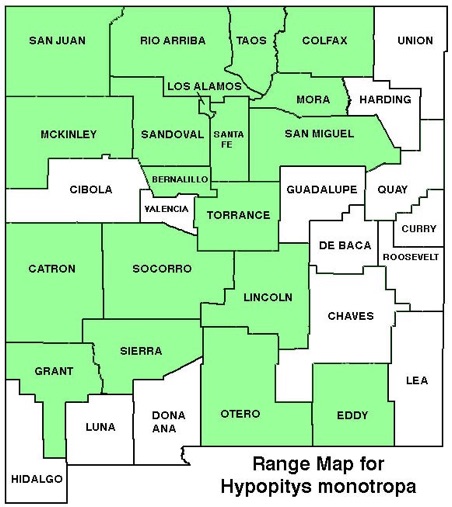WILDFLOWERS OF NEW MEXICO

Red to orangish stems reach 4–12 inches tall with nodding tips lined with small, bell-shaped flowers. Note the plant lacks chlorophyll and grows amongst the leaf litter in dense mixed-conifer forests, but is parasitic on micorrhizal fungus, not tree roots.
FLOWER: July–October. Spike-like clusters grow along a nodding stem, with the same color as the stem, red to orange (common in NM) or yellowish; 4–5 oblong, scale-like petals reach 1/2-inch long (12 mm). The stem turns erect when the fruit capsules form.
LEAVES: Alternate; scale-like, overlapping, 5/8-inches long (15 mm); stem-colored, no chlorophyll present.
HABITAT: Moist to dry, shady forest soils: mixed conifer forests.
ELEVATION: 6,800–9,200 feet.
RANGE: Widespread in U. S. except Great Plains, and deserts.
SIMILAR SPECIES: The red, nodding stems with small, bell-shaped flowers and forested habitat are diagnostic.
NM COUNTIES: Western 2/3 NM in mid- to high-elevation, conifer-forest habitats: Bernalillo, Catron, Colfax, Eddy, Grant, Lincoln, Los Alamos, McKinley, Mora, Otero, Rio Arriba, San Juan, San Miguel, Sandoval, Santa Fe, Sierra, Socorro, Taos, Torrance.









PINESAP
HYPOPITYS MONOTROPA (Monotropa hypopithys)
Heath Family, Ericaceae (formerly Indian-Pipe Family, Monotropaceae)
Perennial herb, parasitic


















THE CONTENTS OF THIS WEBSITE ARE COPYRIGHTED AND CANNOT BE USED
WITHOUT PERMISSION OF GEORGE OXFORD MILLER
















EMAIL ME









-
•Pinesap is nodding in flower (left) but erect in fruit (right)
-
•Scale-like leaves alternate on the stem (arrow).

Pinesap is parasitic on mic0rrhizal fungi and has no green chlorophyll.
















